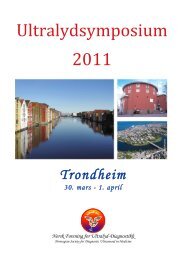Abstrakter - NORSK FORENING FOR ULTRALYD-DIAGNOSTIKK
Abstrakter - NORSK FORENING FOR ULTRALYD-DIAGNOSTIKK
Abstrakter - NORSK FORENING FOR ULTRALYD-DIAGNOSTIKK
You also want an ePaper? Increase the reach of your titles
YUMPU automatically turns print PDFs into web optimized ePapers that Google loves.
The Movement of the Diaphragm during Classical Singing:<br />
A preliminary study on the use of ultrasound as method for monitoring the movement of<br />
the diaphragm<br />
*Viggo Pettersen and **Torbjørn Moe Eggebø<br />
*University of Stavanger, Department of Music and Dance, N-4068 Stavanger, Norway<br />
**Stavanger University Hospital, Department of Obstetrics and Gynaecology,<br />
Stavanger, Norway<br />
Introduction: The diaphragm (DPH) is often described as being dome-shaped, slightly higher<br />
on the right side than on the left side: it is said to resemble an inverted bowl. Many important<br />
organs in contact with its lower surface enjoy the protection of the lower ribs. This is particularly<br />
true for the liver and the spleen, and to some extent the kidneys. This study aimed to investigate<br />
the movement of the medial and posterior parts of DPH.<br />
Material and method: High frequency sound-waves (3.5 mHZ) will be utilized to explore the<br />
movement of DPH. The medial part will be investigated by placing the probe laterally to the<br />
midline, beneath the lowest part of the rib-cage, on the right side of the body. The posterior part<br />
of DPH will be investigated by placing the probe on the back, beneath the rib- cage, to the left of<br />
the midline. This part of DPH is not directly accessible by ultrasound (US). Nevertheless,<br />
because DPH and its associated structures are always supposed to move in concert, the<br />
movement may indirectly be surveyed by studying the movement of the left kidney.<br />
Results: The main finding in this investigation is that US is a promising tool to explore the<br />
movement of DPH during singing. The findings will be discussed and illustrated by analyses of<br />
US imaging.<br />
38











